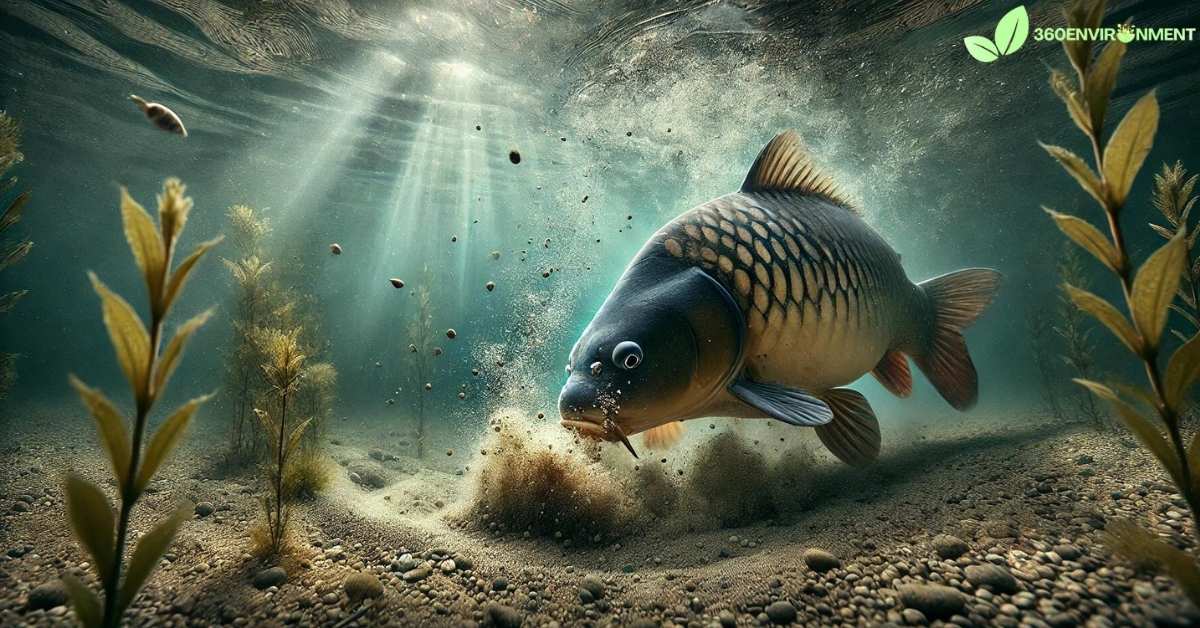What do carp eat? This is a question that many anglers, environmentalists, and aquaculture experts ask, as the diet of carp plays a crucial role in shaping the ecosystems where these fish are found. Carp, including the common carp (Cyprinus carpio), are one of the most adaptable and widespread freshwater fish globally. They thrive in diverse habitats, from shallow ponds to large rivers, and have a diet that reflects their opportunistic feeding habits. As omnivores, carp consume both plant and animal matter, allowing them to survive and even dominate various freshwater ecosystems.
In this article, we will explore what do carp eat, how their feeding behavior influences their environment and the ecological role carp play in aquatic ecosystems. We will also examine how human activities, such as aquaculture and fishing, impact the diet of carp and their broader role in these ecosystems.
1. What Do Carp Eat?
To understand what do carp eat, it’s essential to consider the variety of food sources available to them in freshwater environments. Carp are opportunistic feeders, meaning they consume whatever is available in their environment, including plant material, invertebrates, and small fish. Their diet is highly flexible, allowing them to thrive in a range of ecosystems, from nutrient-rich ponds to rivers with varying water conditions.
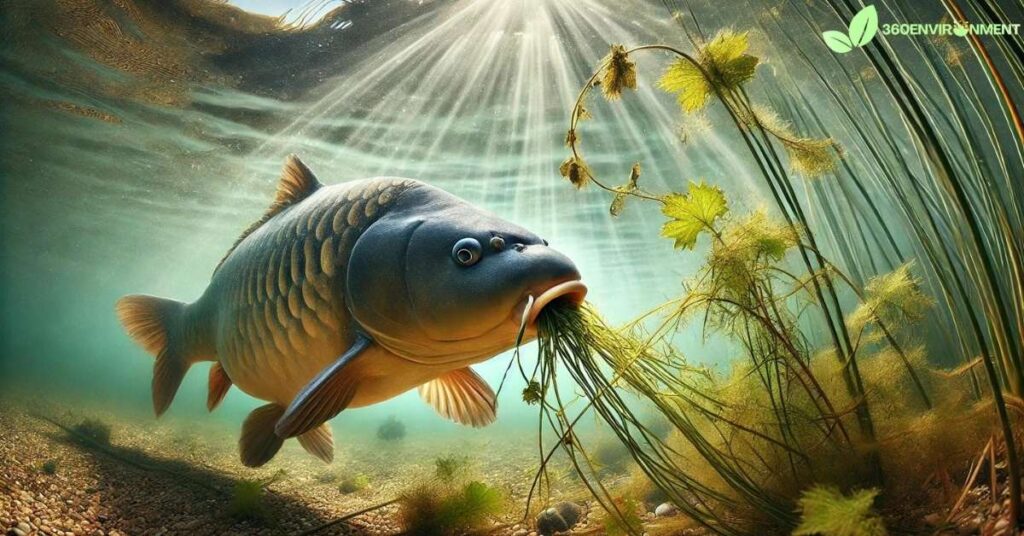
1.1. Plant-Based Diet: The Role of Aquatic Vegetation
A large portion of the answer to the question what do carp eat includes plant-based foods, such as aquatic vegetation, algae, and detritus. Carp are known for their ability to uproot and consume various types of aquatic plants, which can have significant ecological impacts on the habitats they live in.
- Aquatic Plants: Carp feed on a wide range of aquatic plants, including submerged plants like pondweed, floating plants such as duckweed, and emergent species. These plants provide essential nutrients, including carbohydrates, fibers, and vitamins, which support carp’s energy needs and growth.
- Algae and Phytoplankton: Another part of the answer to what do carp eat is algae, particularly filamentous algae, and phytoplankton. Carp graze on algae growing on submerged surfaces, such as rocks and plant stems, helping to manage algal blooms in some environments. Phytoplankton is crucial for younger carp, providing essential nutrients during early growth stages.
- Detritus: Detritus, or decaying organic matter, also forms a significant part of what do carp eat. Carp forage in the sediment for this nutrient-rich material, which includes decomposing plants and animals. By consuming detritus, carp play a role in recycling nutrients in their habitat.
1.2. Animal-Based Diet: Invertebrates, Small Fish, and Aquatic Organisms
In addition to plant material, what do carp eat includes a variety of animal-based foods. Carp consume invertebrates, zooplankton, and occasionally small fish, contributing to their diverse diet and allowing them to meet their protein and energy requirements.
- Invertebrates: A key aspect of what do carp eat is invertebrates, such as insect larvae (mayflies, dragonflies), crustaceans (freshwater shrimp, crayfish), and mollusks (snails, mussels). These invertebrates provide high-protein meals, essential for carp growth and reproduction. Carp use their sensitive barbels to detect invertebrates in the sediment and capture them using their suction-feeding technique.
- Zooplankton: Juvenile carp rely heavily on zooplankton, another part of what do carp eat. Zooplankton includes tiny organisms like copepods, rotifers, and water fleas (Daphnia), which are rich in nutrients necessary for young carp to develop and grow.
- Small Fish and Fish Eggs: Though not a primary food source, small fish and fish eggs occasionally form part of what do carp eat. Carp may consume small fish opportunistically, especially in environments where these prey items are abundant. This predatory behavior is more common during spawning seasons when fish eggs are plentiful.
2. Feeding Behavior of Carp
Now that we have a better understanding of what do carp eat, it’s important to look at how carp feed. Their behavior is shaped by environmental factors, the type of food available, and the season. Carp are primarily bottom feeders, which means they search for food in the sediment of lakes, rivers, and ponds.
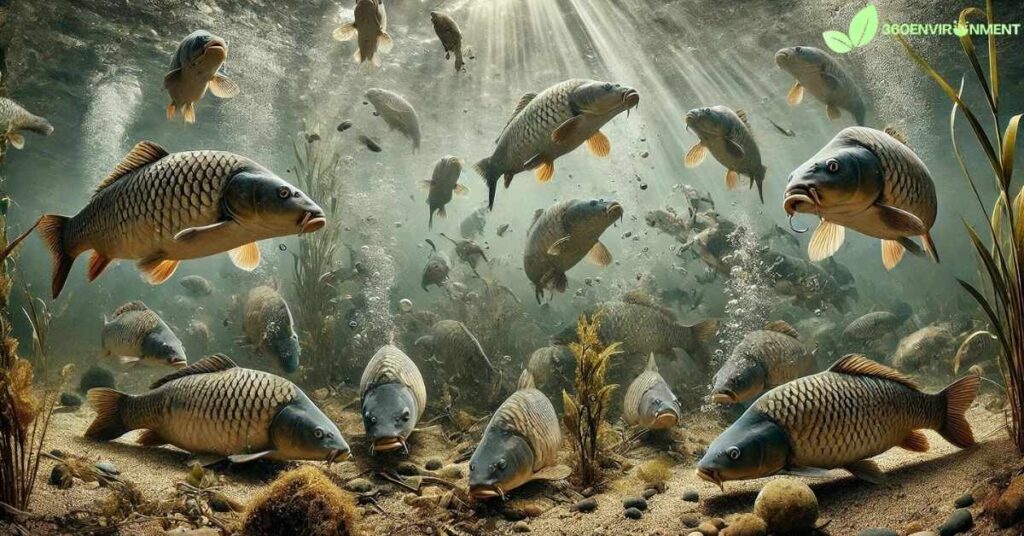
2.1. Bottom Feeding and Foraging Strategies
A key behavior in answering what do carp eat is their bottom-feeding strategy. Carp have evolved a specialized way of feeding that allows them to extract nutrients from the substrate.
- Suction Feeding: Carp use a method called suction feeding, in which they create a vacuum by quickly opening their mouths to suck up food along with sediment. After pulling in sediment, carp sift through it, using their pharyngeal teeth to separate edible material from non-edible particles before spitting out the sediment. This behavior is essential in gathering a wide variety of food items, from plant roots to small invertebrates.
- Bioturbation: Carp feeding behavior also has an ecological impact, known as bioturbation, where they disturb the sediment during feeding. This behavior can release nutrients into the water column, increasing turbidity and promoting algal growth. Understanding this impact is vital for grasping what do carp eat and how they influence their environment.
2.2. Grazing on Aquatic Vegetation
In addition to bottom-feeding, grazing behavior is another part of what do carp eat. Carp are known to clip aquatic plants and scrape algae from rocks or other submerged surfaces.
- Plant Uprooting: Carp often uproot entire aquatic plants while feeding, which can significantly alter the ecosystem. While some plant species benefit from this disturbance, others may struggle, especially if carp are present in high numbers.
- Algal Grazing: Carp feed on various types of algae, which form a critical component of their diet, especially in nutrient-rich environments. This algae consumption is another crucial element in understanding what do carp eat.
2.3. Seasonal Feeding Patterns
Seasonal changes also influence what do carp eat. Carp adjust their feeding behavior according to water temperature and food availability, displaying a variety of feeding patterns throughout the year.
- Spring and Summer: In warmer months, carp exhibit higher metabolic rates and are more active feeders. During this time, what do carp eat includes a wide range of plant material, invertebrates, and other available food sources. Their increased feeding activity supports growth and prepares them for spawning.
- Autumn and Winter: As temperatures cool, carp slow down their feeding and focus on consuming protein-rich foods to build fat reserves for the winter. In colder months, their metabolism drops, and they may consume less or go for long periods without eating, relying on stored energy to survive.
3. The Ecological Role of Carp in Freshwater Ecosystems
Understanding what do carp eat also requires an exploration of their ecological role. Carp are considered ecosystem engineers because their feeding activities have wide-ranging effects on the environments they inhabit. They influence water quality, nutrient cycling, and aquatic vegetation, and they play a role as both prey and predator in freshwater ecosystems.
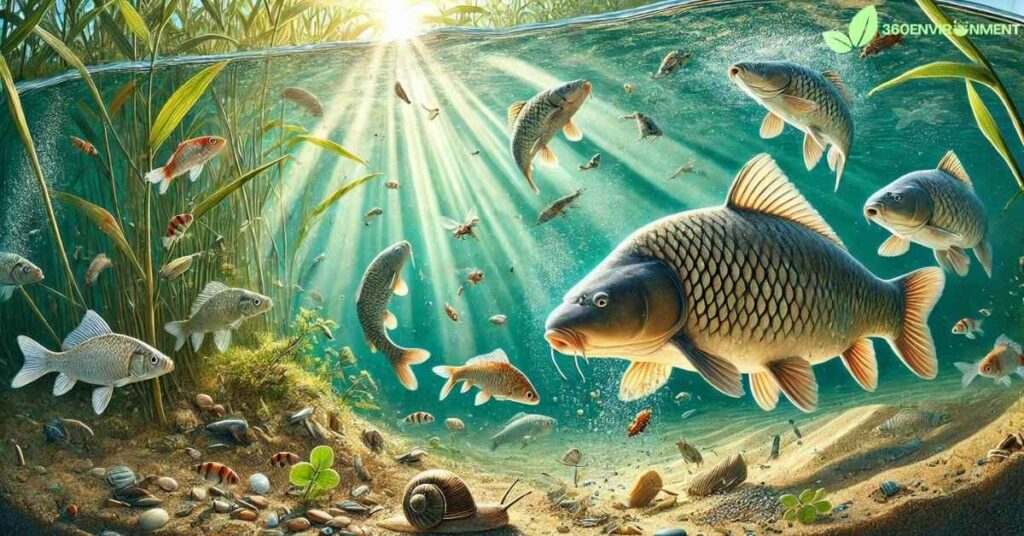
3.1. Carp as Ecosystem Engineers
Carp’s feeding behavior and the answer to what do carp eat make them important ecosystem engineers. Their activity in the sediment helps release nutrients into the water column and can alter the physical structure of aquatic habitats.
- Nutrient Cycling: As carp feed on both plant and animal matter, they contribute to nutrient cycling within the ecosystem. By disturbing sediment, they release trapped nutrients like nitrogen and phosphorus, which can stimulate algal growth and influence the availability of resources for other species.
- Impact on Water Quality: Carp’s bottom-feeding behavior increases water turbidity, which can have a cascading effect on aquatic ecosystems. High turbidity reduces sunlight penetration, affecting submerged plants and algae, which can lead to a decrease in oxygen levels in the water. This highlights the broader environmental effects of what do carp eat.
3.2. Impact on Aquatic Vegetation and Habitat
What do carp eat includes a variety of plant materials, but their feeding behavior can drastically alter aquatic plant communities. Their ability to uproot and consume large amounts of vegetation can lead to changes in habitat availability for other species.
- Destruction of Aquatic Plants: Carp feeding can reduce plant biomass, which can impact species that rely on aquatic vegetation for habitat, breeding, or food. This can have a ripple effect on biodiversity, affecting fish, invertebrates, and amphibians that depend on healthy aquatic plant communities.
- Invasive Carp and Habitat Alteration: In regions where carp have been introduced as invasive species, their feeding behavior can lead to the decline of native aquatic plants and create imbalances in the ecosystem. Invasive carp populations, such as grass carp, are particularly known for their ability to significantly alter aquatic habitats through their feeding.
3.3. Carp as Prey and Predator
Understanding what do carp eat also involves recognizing their role as both prey and predator within the aquatic food web.
- Carp as Prey: Young carp are frequently preyed upon by larger predatory fish, such as pike and bass, as well as birds like herons and kingfishers. Their presence provides an important food source for these predators, contributing to the overall food web.
- Carp as Predator: Adult carp, on the other hand, are active predators of invertebrates, zooplankton, and occasionally small fish. By consuming these organisms, they help regulate invertebrate populations and influence the structure of aquatic ecosystems.
4. Carp in Aquaculture and Human Influence on Carp Diet
Human activities, such as aquaculture and recreational fishing, have a significant impact on what do carp eat. Carp have been domesticated and farmed for centuries, particularly in Asia and Europe, where they are highly valued as a food source. Carp farming practices, along with fishing techniques, have influenced their diet and feeding behavior.
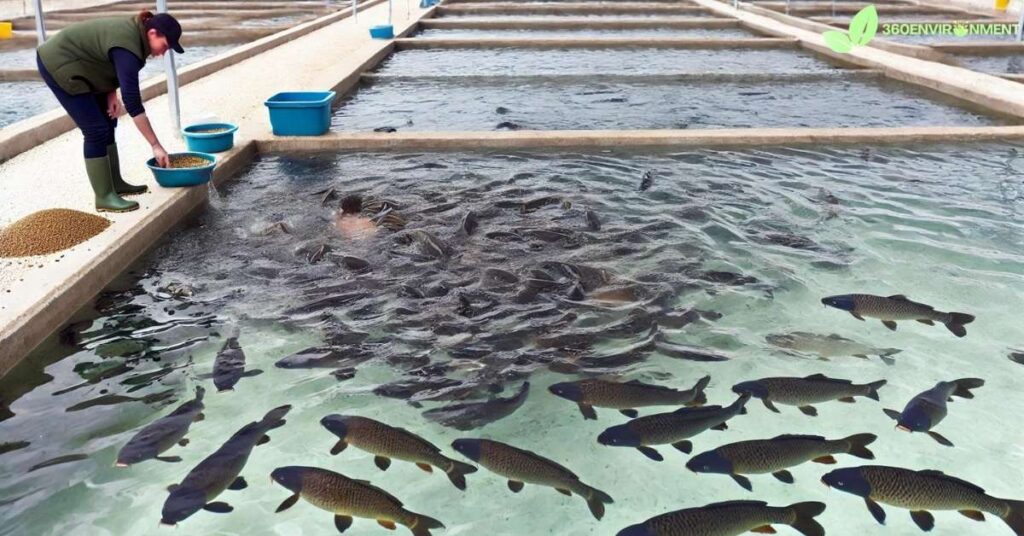
4.1. Carp in Aquaculture
In aquaculture, carp are often provided with specially formulated feed to optimize growth and health. This introduces a different aspect to what do carp eat compared to their diet in the wild.
- Formulated Feed: Farmed carp are typically fed pelleted feed that contains a balanced mix of protein, carbohydrates, fats, and vitamins. These pellets are designed to support rapid growth and ensure that the fish receive all necessary nutrients. The use of pelleted feed reflects the controlled aspect of what do carp eat in farming environments.
- Natural Food Sources: In more traditional farming systems, such as rice-fish farming, carp are allowed to forage naturally in addition to being supplemented with feed. In these systems, what do carp eat includes both natural food, such as insects, plants, and algae, as well as human-provided nutrition.
4.2. Recreational Fishing and the Use of Bait
Recreational fishing has also influenced what do carp eat, particularly through the use of bait to attract carp.
- Fishing Bait: Anglers often use bait such as corn, boilies, bread, worms, or artificial lures to catch carp. This bait introduces new and easily accessible food sources into the environment, influencing what do carp eat. Carp may develop a preference for bait over natural food sources, altering their feeding patterns.
- Impact on Feeding Behavior: Over time, carp may associate certain food types, such as bait, with easy meals, potentially changing their natural foraging behavior. This shift can influence not only what do carp eat but also how they interact with other species in their habitat.
5. Conservation and Management of Carp Populations
The wide-ranging impact of what do carp eat and their feeding behavior means that managing carp populations is essential for maintaining ecological balance. While carp are a valued species in aquaculture, they can also become invasive and disruptive in regions where they have been introduced.
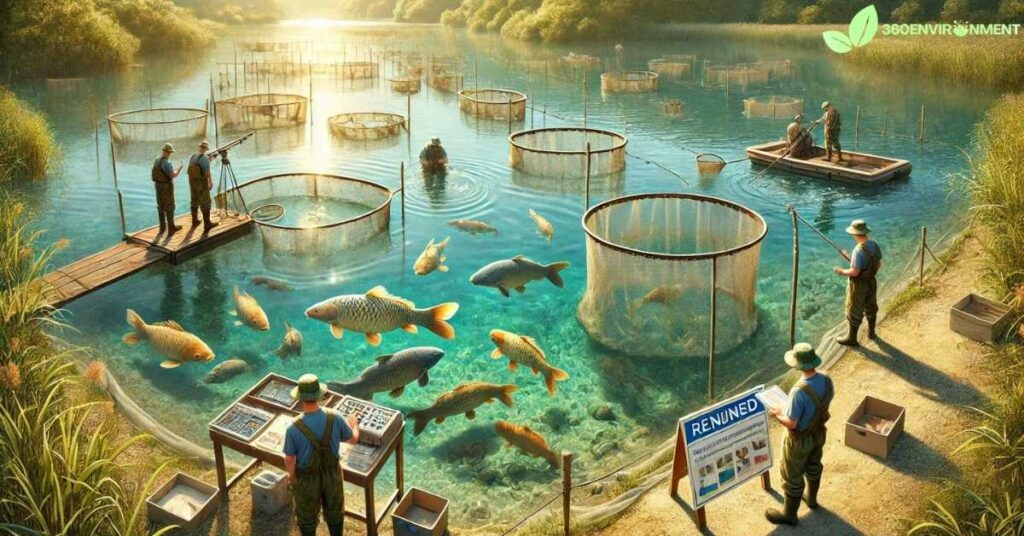
5.1. Managing Invasive Carp Species
In areas where carp have been introduced outside of their native range, their impact on native ecosystems can be profound. Invasive carp, such as common carp and grass carp, often outcompete native species for food and habitat, leading to ecosystem degradation.
- Ecosystem Restoration: In regions where invasive carp have disrupted native plant and animal communities, conservation efforts focus on removing carp and restoring native habitats. Understanding what do carp eat is crucial for developing effective management strategies that balance carp populations with ecosystem health.
- Population Control: Efforts to control invasive carp populations include targeted removal through fishing or netting, the use of barriers to prevent their spread, and biological control measures such as introducing natural predators.
5.2. Sustainable Carp Farming Practices
Carp farming remains an essential part of global aquaculture, particularly in Asia and Europe. Ensuring that carp farming is sustainable is critical for both environmental and economic reasons.
- Integrated Aquaculture: One approach to sustainable carp farming is integrated aquaculture, where carp are raised alongside other species, such as shrimp or rice. This method mirrors natural ecosystems and helps reduce the environmental impact of carp farming by promoting nutrient recycling and reducing waste.
- Water Quality Management: In carp farming, maintaining high water quality is crucial to preventing disease outbreaks and ensuring the health of the fish. Proper management of nutrients and waste products helps maintain the balance of the ecosystem and reduces the environmental footprint of aquaculture.
Conclusion: The Role of Carp and Their Diet in Ecosystems
What do carp eat is a fundamental question that helps us understand their ecological role in freshwater ecosystems. Carp’s omnivorous diet allows them to thrive in diverse habitats, and their feeding behavior influences nutrient cycling, water quality, and aquatic vegetation. While carp are valuable for aquaculture and recreational fishing, their ability to disrupt ecosystems when introduced as invasive species highlights the need for careful management.
By understanding what do carp eat and how they interact with their environment, we can develop strategies to balance carp populations with the health of freshwater ecosystems. Carp will continue to play an important role in both natural and human-influenced aquatic environments, but managing their impact remains key to ensuring the sustainability of these systems.
Read More: The Environmental Niche of the Horn Hatchet fish: Understanding Its Ecology, Behavior, and Habitat

